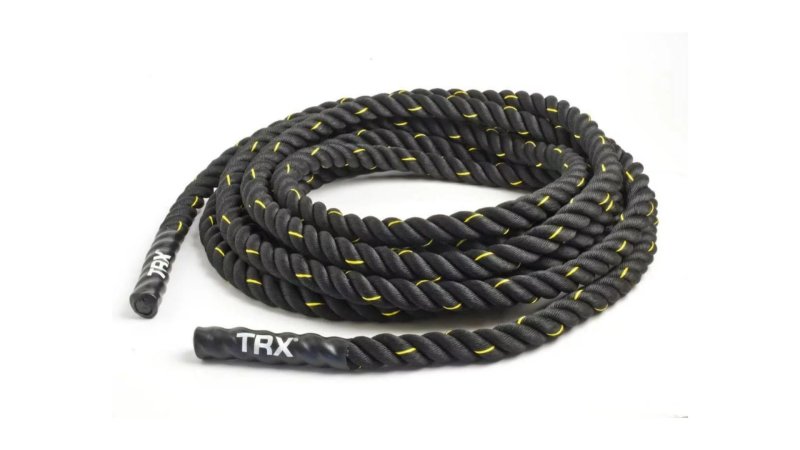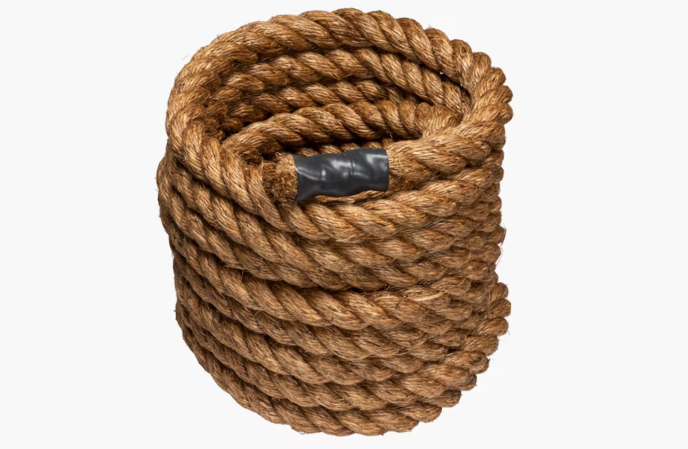

We may earn revenue from the products available on this page and participate in affiliate programs.
Battle ropes are growing in popularity, and you might be wondering if you should add one to your home gym. Are battle ropes worth it? They’re not a magic answer to all your fitness woes; nothing is. But battle ropes can be a good way to mix up your cardio and strength training with a high-intensity exercise that’s engaging and fun. That’s something we can all benefit from.
Battle ropes (also called workout ropes or exercise ropes) are very versatile and can be used for strength and conditioning with a range of compound movements. They can help you improve your cardiovascular fitness with high-intensity training that’s more efficient (and more fun) than slogging through another run around the neighborhood. With a little creativity, you can even use them to train your lower body with various drags and pulls.
Alongside other gym staples like power racks, weight benches, barbells, and resistance bands, the best battle ropes can help put everything you need to achieve peak physical performance in your own home. We chased down some of the very best premium, value, and homemade battle ropes out there so you can stop shopping and start working out. We also rounded up the information you need to understand how to use battle ropes, make an informed decision, and make the best use of your new workout ropes.
- Best Overall: TRX Battle Rope
- Best Value: Manila Jute Rope
- Honorable Mention: Rogue Conditioning Rope
- Best Anchor Straps: Eclipse Fitness Battle Rope Anchor
Methodology
Battle ropes are simple enough, but they’re also a fairly versatile piece of gym equipment. I started by brainstorming all the ways people use them — high-intensity cardio, dragging, pulling, and climbing — and searched for products that can handle everything you might throw at them. Next, I cut out all the sketchy suppliers with no reputation for providing a quality product. Finally, I looked for solid workout ropes and rope anchors across a range of prices to make sure everyone can find something that fits their budget. I even included a do-it-yourself option so you can spend the money you save on other gym essentials.
Best Overall
TRX Battle Rope
Pros
- Synthetic rope holds up well against wear and tear
- Beefy rubber handles add durability and improve grip
- Premium quality worthy of a commercial gym
Cons
- About as expensive as battle ropes get
- Synthetic rope can feel rigid compared to natural fibers
Product Specs
- Material: Unspecified synthetic fibers
- Diameter: 1.5 inches
- Length: 50 feet
Best Value
Manila Jute Rope
Pros
- A fraction of the cost compared to name-brand battle ropes
- Three different sizes are available
- Built using quality jute stem fibers
Cons
- You’ll need to add your own handles
- Light and flexible rope doesn’t provide the most challenging workout
Product Specs
- Material: Jute fibers
- Diameter: 1.5 inches
- Length: 50 feet
Honorable Mention
Rogue Conditioning Rope
Pros
- Feels nice and heavy for a good workout
- Very strong with a load rating of 500 pounds
- American-made using natural fibers
Cons
- Constant cleanup caused by messy natural fibers
- Frayed ends could degrade over time
Product Specs
- Material: Natural manila fibers
- Diameter: 1.5 inches
- Length: 50 feet
Best Battle Rope Anchor Straps
Eclipse Fitness Battle Rope Anchor
Pros
- Nylon strap doesn’t damage ropes
- Fits any post, pole, or tree under 14 inches in diameter
- Can be unclipped without undoing either end
Cons
- Not strictly necessary for all exercises
- Requires some kind of sturdy post or beam
Product Specs
- Material: Nylon
- Diameter: designed for ropes with 1.5- to two-inch diameters
- Length: compatible with posts 14 inches in diameter or less
Our verdict on battle ropes
The TRX Battle Rope is a premium item that deserves a place in your home gym or even a commercial gym. If you’re looking for the least expensive battle rope possible, your best bet is to build your own from jute rope and duct tape.
What to consider when buying a battle rope
Battle ropes are extremely simple, so it doesn’t take long to learn enough to make an informed buying decision. You basically need to understand how a product is made, what kind of features it uses to stand out from the crowd, and how it will fit into your existing home gym setup.
Battle rope key features
Rope material
Your first objective should be to determine what kind of rope you should buy. Spending more money will allow you to get stronger materials, but that may or may not be worth the extra cost. The least expensive exercise rope you’re likely to find is bulk jute rope. Jute is a natural plant fiber that is popular around the world for its availability, strength, and low cost. While not as durable as hemp or nylon rope, it can be a great option for battle ropes, which aren’t load-bearing. Just be aware that even though jute is extremely heat-tolerant, it’s relatively light and may shrink when exposed to moisture.
Upgrading to synthetic fibers will get you more strength, water resistance, and durability. Nylon rope is stronger and more resilient than jute, hemp, and polypropylene. It also holds up well to UV exposure, making it a great choice for outdoor gyms. These advantages aren’t cheap, though. Expect to pay more upfront for nylon workout ropes with the understanding that the material should last a very long time.
Grips
The best battle ropes come with grips installed at each end. This allows you to keep a firm hold on the rope while minimizing wear that can separate individual strands over time. They also keep the rope squeezed tightly so it’s less likely to start unraveling.
If you choose to make your own battle ropes, you can make your own grips with duct tape. Wrap the tape tightly in two overlapping layers for a secure, lasting grip that will protect your rope and your hands.
Anchor
To be used effectively, battle ropes should be anchored in the center. A solid anchor lets each end move independently. The most popular anchors are ones that are designed specifically for battle ropes. They’re intended to be secured to a post and may include a carabiner so one end can remain installed while the other can be disconnected with your battle rope and put away when not in use.
If you’re building a low-budget home gym, you can always anchor your battle rope by placing a heavy object over one end. A simple sandbag, kettlebell, or U-bolt attached to a fixed point can do the trick. Just be aware that improvised anchors might accelerate wear on your rope compared to a manufactured anchor.
Battle ropes pricing
The best battle ropes from reputable manufacturers cost between $100 and $200. That will get you durable synthetic ropes with built-in handles for excellent grip. Budget-friendly DIY setups can be pieced together for less than $75. If you want a convenient, purpose-built battle rope anchor, expect to pay about $15.
FAQs about battle ropes
You’ve got questions, Task & Purpose has answers.
Q: How do you anchor battle ropes?
A: All you need is something to hold the center of the rope still while you use each end. That can be a purpose-built anchor attached to a post or something like a heavy sandbag placed over the rope.
Q: Are battle ropes for cardio or strength training?
A: Battle ropes are used for high-intensity training that can improve muscular strength, endurance, and power. You’ll be using compound movements that translate to real-world fitness in a wide range of applications.
Q: What muscles do battle ropes work?
A: Because battle ropes require compound movements, you’ll be using several muscle groups. They’re primarily designed to activate the arms, chest, shoulders, and upper back. In order to maintain a stable platform, you’ll need to maintain tension in your legs and core, as well.



